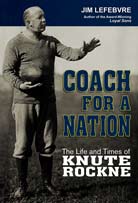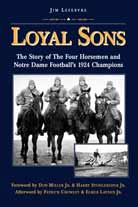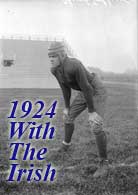Notre Dame’s First Bowl Trip
Was One For The Ages
Knute Rockne’s “wonder team,” led by the Four Horsemen and the Seven Mules, ripped through the regular season with a 9-0 mark, before heading to southern California for a January 1, 1925 meeting with Pacific coast champion Stanford at the Rose Bowl. It would be no ordinary trip, but rather a three-week celebration of this special group of young men. In a time of widespread anti-Catholicism, the Irish were becoming a source of intense pride for Catholics across the U.S.
The train trip began from Chicago Dec. 20, with lengthy stops in Memphis, New Orleans, Houston and Tucson en route to Pasadena. The return trip started with several days in the Bay area, followed by celebratory stops in Salt Lake City, Denver, Cheyenne and Lincoln, Nebraska, before returning to Chicago and finally campus.
When Knute Rockne stepped off the train in Tucson, he looked up at a bright blue sky and broke into a wide grin, rubbing his hands together in anticipation. Finally they had encountered the mild weather he had hoped for. Minutes later, after a member of the welcoming committee gave him the schedule of receptions, dinners and banquets, his mood darkened. Rockne thought that his club was already showing the physical and psychological effects of too many feasts on the trip and that the players needed a different regimen. His hosts explained that special care was being taken to feed his players healthy food and allow them plenty of rest, and he again smiled and gave his approval….
Originally, there was no practice scheduled for Sunday, but Rockne decided to add one to make the best use of the good weather and available time. “We have been giving alibis for four days,” the coach scolded his players. “We are going to get down to business. We’ve got a reputation to uphold and we are going to win from that coast gang.” After the session, Rockne expressed satisfaction with the workout, saying his players were returning to form.
| 1924 With The Irish November 8: It Was An Action-Packed Election Week in Wisconsin: Fighting Bob, Sousa, Four Horsemen |
In Glenn Scobey “Pop” Warner of Stanford, the Irish would face one of the most experienced, accomplished and innovative coaches in college football history. The wily veteran had seen almost everything in his 30 years as a college coach – and much he had developed himself. The spiral pass, numbered plays, the dummy scrimmage, the double-wing formation, the unbalanced line were all the creative work of Warner.
Pop Warner had amassed a record of 60-12-4 in the previous nine seasons at Pitt, and in coming to Palo Alto, he inherited one of the great talents of the game – fullback Ernie Nevers. The great back was frequently injured in 1924, but was ready to go in the Rose Bowl despite two sore ankles. Warner had assembled a huge body of information on Notre Dame’s formations and tendencies, prompting one commentator to write, “Never before did a coach have as much information about a team as has Warner. The intelligence section of the United States expeditionary force during the World war…was a mere amateur compared to Warner’s volunteer informants.”
Football fans were now pouring into Pasadena and environs. Those still wishing to find a ticket descended on the Stanford headquarters in the hopes, against all odds, of finding one. A special train filled with Notre Dame alumni and Knights of Columbus members from the San Francisco area headed south on Monday evening. A special from Chicago carrying Notre Dame alumni and fans….rolled into town Tuesday. One report said the travelers “have plenty of money, given them by Notre Dame enthusiasts back home, to wager on the result.” Stanford backers demanded 2-to-1 odds, though the “experts” were making the Irish an 8-to-5 favorite.
Stanford was expected to have the edge in color and student support. There would be a full rooting section including 1,100 Stanford students, equipped with brilliantly-colored cards and organized stunts. A 72-piece Stanford band was preparing to march in the Tournament of Roses parade and to accompany the rooting section at the game. Notre Dame would need to rely mainly on its support within the general admission audience as well as the attending alumni….The Irish had support from many quarters. Hundreds of alumni of various eastern and Midwest schools purchased blocks of tickets in adjoining sections and planned to cheer for Notre Dame.
For millions of fans across the country, the game would enter their homes via radio broadcasting, with four stations providing coverage. A direct wire from the field in Pasadena to the WGN studios in Chicago was to be relayed to WCBS in New York, resulting in “the first time in radio history that Eastern stations have broadcast direct a Pacific coast event.” Across the Midwest, telegraph offices in countless towns and cities planned to remain open on the holiday to receive reports from Pasadena. By all accounts, the game would be the most widely followed in the history of football.
A huge crowd greeted the Irish upon their arrival in Los Angeles, including world heavyweight champion Jack Dempsey. Fans strained to get a look at the “four horsemen,” the “seven mules” and their teammates. The players were hustled into waiting autos for the ride to their headquarters at the Maryland Hotel. There, another rousing reception awaited the squad, and people jammed the lobby day and night hoping to see any of the lads in person. Chicago’s Walter Eckersall, in his dispatches back to Chicago, noted that “never before in the history of football along the Pacific seaboard has so much interest been shown in a pending gridiron struggle.” The game would be seen by a capacity crowd of 53,000, and “if the stadium was larger, double that number of tickets could have been sold.”
January 1, 1925 began in customary fashion in Pasadena with the annual Tournament of Roses parade, a colorful assemblage of pageantry attracting tens of thousands of viewers to the city’s streets. Throughways were clogged with traffic for hours after the last of the floats finished the route. Despite that, the 53,000 seats of the Rose Bowl stadium in the Arroyo Seco valley were filled by 1:45 p.m., a half hour before the scheduled kickoff. An estimated 10,000 cars were parked nearby.
In the hills surrounding the valley, thousands more onlookers took their spots alongside the eucalyptus trees. In the distance, the snow-capped San Gabriel mountains stood sentinel over the scene. Down below, the Rose Bowl’s grass field gleamed in the brilliant sunshine. The soft breeze created perfect comfort. It was, said one observer, all the Chamber of Commerce could have hoped for.
Up until game time, Rockne had been vague about who he planned to start. But he continued the season’s strategy of starting the Shock Troops – a complete second unit meant to take some of the energy out of the opposition’s starters. They kept Stanford off the scoreboard on its first possession, even nailing Nevers for a loss on a fake double-pass.
The Shock Troops had held, and now it was time for the regulars. The crowd roared as they saw the “four horsemen” and “seven mules” take the field. On the first play from the Irish 20, Don Miller took the snap and started around left end, as he had so many times during the season. This time, though, he lost control of the ball and Stanford’s Johnston recovered on the Irish 17, sending the red-clad rooters into hysteria. Nevers plowed to the 13. The mighty fullback churned for two yards to the 11. With Walsh, Kizer and Weibel on alert, Cuddeback tried to go around end, but failed. On fourth down, Cuddeback made the 20-yard placekick for a 3-0 Cardinal lead.
The Irish then drove to the Stanford 5, only to be stopped. On a fourth-down pass attempt, Stuhldreher was clobbered, and lay crumpled on the turf. Shortly after, tackle Joe Bach suffered an injury the Irish believed to have been caused by a steel brace worn on a Stanford player’s knee. The Irish, with Stuhldreher limping badly, stiffened their resolve, and drove to their first touchdown, with Layden plowing over for a 6-3 lead. But the Cardinal continued to press.
Everything old “Pop” tried seemed to be working. He was especially fond of plays that kept Cardinal backs wide in the backfield for a pass, then upfield once they had the ball. But the Irish were spotting the pattern, and it matched what Coach Madigan of St. Mary’s had told them. On a third-and-five from deep in Irish territory, Nevers faded and attempted a cross-field pass. Elmer Layden anticipated this play and perfectly timed a leap between two Cardinal targets. The ball hit his shoulder and bounced a few feet over his head. But Layden kept his eye on the ball, snared it in his arms and continued running. With his sprinter’s speed, Layden dashed into an open field. Within seconds, there was only a Blue-jerseyed horseman accompanying him. Layden waltzed into the end zone to complete a 78-yard play. Frenzied Notre Dame backers jumped and hugged. Crowley made the kick and the Irish led, 13-3.
Early in the second half, ND still leading 13-3, Stanford bobbled a punt by Layden. Solomon dove for the ball but Chuck Collins brushed him aside, and Irish end Ed Hunsinger flew past, picking up the ball and racing 20 yards into the Cardinal end zone. Another huge Stanford miscue had resulted in Notre Dame’s 20-3 lead. However, Stanford had far too much pride to lie down. Nevers, like a human battering ram, led another charge downfield, and threw a short TD pass to pull Warner’s troops to within 20-10 heading into the final quarter.
Warner’s crew had ten points to make up in 15 minutes of play. The next few minutes would be critical. Stanford’s Baker made the first big play, stepping in front of a Layden pass at the Irish 25. The Cardinal, now playing with the confidence of a champion, drove relentlessly. Nevers made three yards over right tackle, then three more on the left side. On fourth-and-one from the 10, the Cardinal star drove for four yards to the six.
By now the brilliant sun had dropped behind the mountains and the chill of nightfall hung over the stadium. On each play, the throngs roared. A Stanford touchdown here could cut the lead to three points. Nevers had to have the ball. He dragged Irish tacklers for four yards to the 2. Another play gained a yard. Nevers made a half-yard dash – fourth down inside the 1-yard line. Adam Walsh encouraged his mates as they bunched together on the Irish goal line. They had a pretty good idea of who was headed their way. Nevers took the snap, smacked into the ND wall and fell forward. Harry Stuhldreher ignored the piercing pain in his ankle and drove his 152-pound frame into the pile. The stack of gridders was untangled and revealed the football – less than six inches short of the goal line. Notre Dame ball. Stanford hearts sank.
Stanford’s last-ditch comeback effort was thwarted by two more ND interceptions, first by Crowley and then another returned 63 yards for a TD by Layden, providing the final 27-10 margin.
The gun sounded and the battle of the ages was history. Notre Dame had survived the knockout punches of a great opponent, made the most of its opportunities and capped its most memorable season to be truly crowned with glory.
The preceding excerpts are from the award-winning book, Loyal Sons: The Story of The Four Horsemen and Notre Dame Football’s 1924 Champions (2008, Great Day Press, 288 p.) by Jim Lefebvre.






